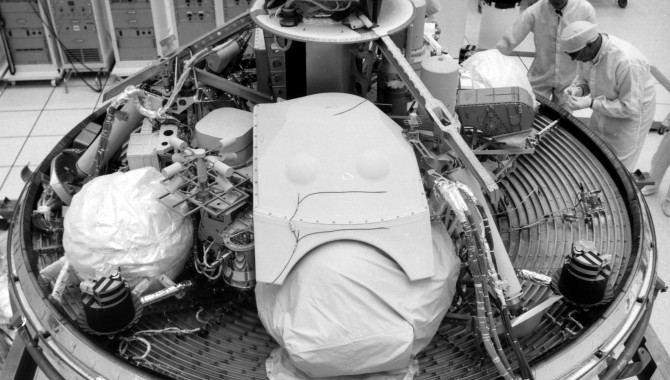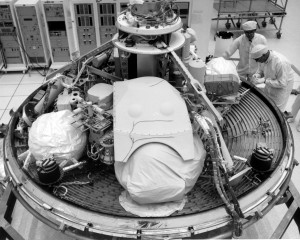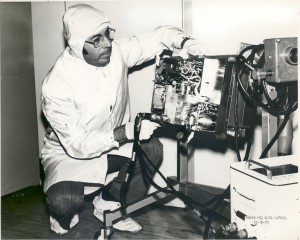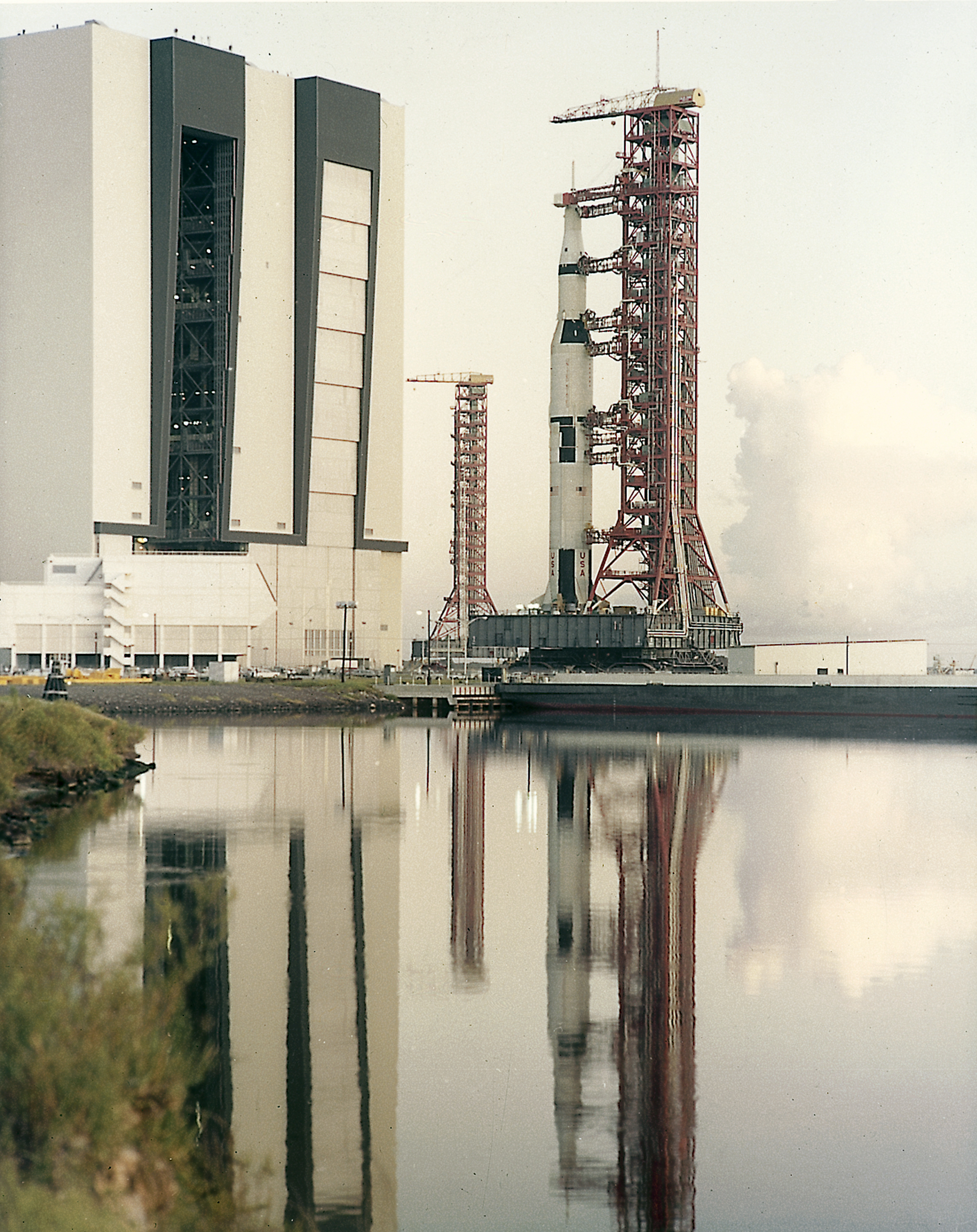
By Matthew Kohut
The primary objective of the Viking science mission was the stuff of dreams: to look for evidence of life of Mars. One of the instruments at the core of the mission was the gas chromatograph-mass spectrometer (GCMS). The GCMS was actually two instruments in one: a gas chromatograph and a mass spectrometer. Conducting gas chromatography and mass spectrometry in a laboratory was hard enough. Building even a lab model required experts who could keep up with the latest developments in the field, since the science was changing rapidly. The GCMS that Dr. Klaus Biemann, the leader of Viking’s molecular organic analysis team, had at MIT was the size of a room; its human operator could literally walk through it. Shrinking the instrument to a mass of less than 15 kg and to fit in a 1′ x 1′ x 1′ box on a spacecraft, operate robotically, and survive the rigors of the journey to Mars and the Martian atmosphere presented myriad challenges.

Technicians inspect Viking Lander 2 in Kennedy Space Center’s Spacecraft Assembly and Encapsulation Facility #1.
Photo Credit: NASA Headquarters
The technical challenges were compounded by managerial ones, including inadequate supervision and lack of communication among the contractors responsible for elements of the instrument. These concerns put the GCMS on Viking project manager Jim Martin’s “Top Ten Problems” list. Experienced, attentive management and a focus on performance over politics and standard operating procedures led to the instrument’s eventual success.
A Neglected Stepchild
In August 1968, the Jet Propulsion Laboratory (JPL) was given responsibility for developing, fabricating, and testing a lightweight portable “breadboard” (experimental model) of the GCMS before selecting a contractor to build the flight hardware. JPL also had responsibility for designing and building the Viking orbiters, managing tracking and data acquisition through the Deep Space Network, and managing the Viking mission control and computing center.
In September 1970, Cal Broome, who headed the working group in charge of overseeing Viking’s scientific payloads, told Martin that the GCMS was a “stepchild” not getting proper supervision because of the decentralized management structure at JPL. Two weeks later, word came back that JPL had taken steps to strengthen its control of the project, but the changes did not yield the results that Martin wanted. In January 1971, a five–day GCMS engineering model review was a disaster, resulting in between 200 and 300 “request for action” forms. The instrument’s mass and cost both far exceeded earlier estimates. At the March Science Steering Group meeting, Martin noted that funding increases, technical problems, and schedule slips were causing considerable concern about the future of the GCMS.
The picture was not entirely bleak. That same month, the GCMS breadboard operated for the first time as a completely automated soil–organic–analysis instrument. Several technical problems were encountered, but Martin and the Viking Project Office considered it a step forward. There was no question about the JPL team’s technical talent; Martin’s concern was its ability to deliver a working instrument in time for launch.

The flight GCMS is tested and prepared for its long journey through space to investigate Mars.
Photo Credit: NASA Headquarters
JPL’s oversight of the instrument’s contractors was a major source of concern. Beckman Instruments (gas chromatograph), Perkin-Elmer (mass spectrometer), and Litton Industries (data system) were building the components of an instrument that required the highest degree of integration, yet the three wouldn’t even talk directly to one another, despite the fact that their facilities were within a fifty–mile radius in California. None had been designated as prime contractor.
In October 1971, Martin considered finding another organization to handle the GCMS contract. The project office awarded Bendix Aerospace a contract to study the feasibility of using an organic analysis mass spectrometer (OAMS) in place of the GCMS. On October 26, he added the GCMS to the Viking Top Ten Problems list.
Martin began the Top Ten Problems list in the spring of 1970 to give problems that could affect the launch date needed visibility and oversight. To make the list, a problem had to have a serious impact on “the successful attainment of established scientific and/or technical requirements, and/or the meeting of critical project milestones, and/or the compliance with project fiscal constraints.” Anyone associated with the Viking project could identify a potential priority problem by defining the exact nature of the difficulty and forming a plan and schedule for solving it. When Martin made an addition to his list, a person in the organization was charged with solving the problem, and someone in the project office monitored the progress.
Time for Action
At the February 1972 Science Steering Group meeting, a top scientist reported on the GCMS and OAMS, noting that both had advantages and disadvantages that could not be directly compared. That settled it for Martin. He decided in favor of continuing the development of a simplified version of the GCMS. He removed the GCMS from the Top Ten Problems list for the time being, knowing that in March he would take concrete steps to get the instrument on track. Martin decided to shift management of the GCMS from JPL to his Viking project office at Langley. According to cost projections, it would be cheaper by about $7.5 million to keep the GCMS project (rather than shifting to an OAMS) while transferring management of it to Langley.
This decision to take the GCMS project from JPL was not made lightly. Though technically not a government institution, JPL was an integral part of the NASA family and the Viking mission. Martin knew his decision would cause rumblings, but the potential political fallout was preferable to launching the Viking spacecraft without a GCMS—an instrument critical in the search for signs of life on Mars. Although its development and fabrication were still far from ensured, he was confident that the project office at Langley could bring needed discipline. He sent Angelo “Gus” Guastaferro, Deputy Project Manager for Management, to California to rewrite the GCMS contract with JPL, and he appointed Joseph C. Moorman to manage the instrument.
Back in the Top Ten
Moorman, who had been managing a biology instrument prior to taking over the GCMS, did not have experience corralling contractors or shifting a project from one center of operations to another. The Viking project was the first in his NASA career, and the difficulties presented by the GCMS would have been an extraordinary challenge for even a seasoned project manager.
Six months later, Martin concluded that Moorman had not brought the GCMS up to speed. This was not a routine science instrument; it required strong systems engineering and experienced project management. He put the GCMS back on the Top Ten Problems list, where it remained for more than two years until shortly before launch.
Beyond the Org Chart
By the end of 1972, Martin took action again. He reassigned Moorman and put Guastaferro, his deputy for management, in charge of overseeing the instrument’s development on a day–to–day basis. Martin did not care about Guastaferro’s title; he needed a senior person who could take effective control of the project and the contractors.
Guastaferro’s first task was to establish a more productive and cooperative relationship among the contractors; his strategy was to shift from “inattention” to “over–attention.” He left Langley and relocated to California for the next two years so he could shuttle among their facilities to monitor progress. He also assigned Litton Industries responsibility as the instrument’s prime contractor, since its data system would ultimately integrate the information from the gas chromatograph and the mass spectrometer and send data back to Earth.
Reaching Out for Answers
Guastaferro relied on Al Diaz, the GCMS chief engineer, to provide the technical expertise that the project required, since there were still significant problems to resolve. Guastaferro and Diaz sought help wherever they could find it, often reaching out to experts in private industry and academia for answers. On more than one occasion, they discovered that others had overcome similar technical issues, but the solutions were proprietary or classified.
The Launch
One by one, dozens of technical issues were resolved. The GCMS critical design review in mid–July 1973 found only three major outstanding concerns, a vast improvement considering the previous difficulties with the instrument.
In May 1975, science payload manager Cal Broome advised Jim Martin that he could remove the GCMS from the Top Ten Problems list. Three months later, on August 20, 1975, Viking I was launched, followed by Viking II on September 9, 1975. In the summer of 1976, the Viking landers began sending GCMS analyses of Martian soil and atmosphere back to scientists on Earth.
The Viking Gas Chromatograph–Mass Spectrometer
The gas chromatograph used a thin capillary fiber known as a column to separate different types of molecules, based on their chemical properties. Each type of molecule passed through the column at a different rate, emerging from the column in a defined sequence. The temperature of the column determined the rate of separation.
Once processed by the gas chromatograph, molecules would then enter the mass spectrometer, which would evaluate and identify them by breaking each one into ionized fragments and detecting these fragments using their charge-to-mass ratio. This produced a unique profile of each compound that could be converted into a digital signal and transmitted to Earth.
Used together, these two components offered a much finer degree of substance identification than either unit used separately. Scientists considered the GCMS a gold standard for forensic substance identification because it performed a specific test. (A specific test positively identifies the actual presence of a particular substance in a given sample.) A working GCMS was absolutely critical to the organic analysis of the soil on Mars.








